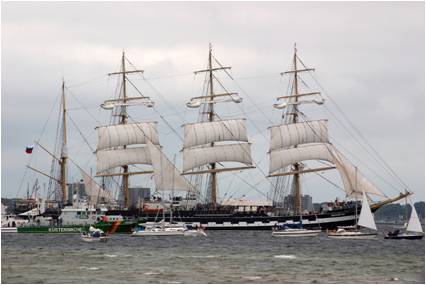Modern Vs. Old-School International Shipping
While we may think that modern international shipping is profoundly different from old-school under-sail shipping, a brief look at the history of the golden age of sail may tell a different story.
The power of supply and demand as well as the ingenuity and skill of mariners of the past meant that some cargo crossed the seas remarkably fast, and the economics of transoceanic commercial voyages are very familiar to modern international shipping companies like Universal Cargo Management.
The Great Tea Race of 1866
 I recently read an article entitled The Great Tea Race of 1866 in the online version of Smithsonian Magazine. The article details how key conditions conspired to make it profitable for elite cargo vessels (multi-masted trans-oceanic clipper ships) to race across the sea from Hong Kong to England.
I recently read an article entitled The Great Tea Race of 1866 in the online version of Smithsonian Magazine. The article details how key conditions conspired to make it profitable for elite cargo vessels (multi-masted trans-oceanic clipper ships) to race across the sea from Hong Kong to England.
First, there needed to be sufficient incentive to make racing the hazardous sea lanes from the far east to the isle of Britain worth the risk. In the late 1800s the incentive was a marked increase in profit margins for the first ships to arrive in the new season carrying one particular cargo: tea.
Tea was just the right import – the season’s first harvest was in demand enough to make it worth it (10% premium on the first load of tea cargo to make it to port!) to race the cargo home.
Also, tea was light enough to enable the ships to travel fast. Many heavier, bulkier cargos would have slowed the travel time from Hong Kong to Britain considerably. All these factors combined to create an economy that supported fierce competition to bring in the season’s first shipment of tea.
The demand for tea was also the catalyst for technological advancement in shipbuilding. Shipwrights labored to develop hulls that were more hydrodynamic and sails that would take advantage of every puff of wind. It was all to the end of increasing the speed of commercial trans-oceanic voyages, especially the delivery of tea.
Cargo Vessel Designs and Profit
These advancements in ship design set the stage for epic competitions between shipping companies, each one developing and racing their fastest clippers across the ocean in an attempt to arrive first and claim the highest prices for their precious cargo.
Investors who had shelled out 15,000 BP to build these super-fast ships could recoup as much as 3,000 BP in the ships’ first cargo voyage. With such high profit potential, many were willing to invest in top ship designs and pay to have them captained by a few elite mariners. These captains worked relentlessly throughout the voyage to maximize their vessel’s speeds.
International Shipping Today
Modern carriers may be more likely to use slow steaming than race to a port finish line, but today’s competitive international shipping industry isn’t so different. Profit margins are tight and the ability to bring valuable cargo swiftly but safely into port still has its rewards.
At Universal Cargo Management, we love that we get to continue in the great tradition of transoceanic shipping. We might not be designing faster cargo vessels, but our 25+ years of experience and service as a freight forwarder could help you be profitable with your ocean freight.


This article was worth reading and the race is really competitive!!